Chen Xing
MultiNRC: A Challenging and Native Multilingual Reasoning Evaluation Benchmark for LLMs
Jul 23, 2025Abstract:Although recent Large Language Models (LLMs) have shown rapid improvement on reasoning benchmarks in English, the evaluation of such LLMs' multilingual reasoning capability across diverse languages and cultural contexts remains limited. Existing multilingual reasoning benchmarks are typically constructed by translating existing English reasoning benchmarks, biasing these benchmarks towards reasoning problems with context in English language/cultures. In this work, we introduce the Multilingual Native Reasoning Challenge (MultiNRC), a benchmark designed to assess LLMs on more than 1,000 native, linguistic and culturally grounded reasoning questions written by native speakers in French, Spanish, and Chinese. MultiNRC covers four core reasoning categories: language-specific linguistic reasoning, wordplay & riddles, cultural/tradition reasoning, and math reasoning with cultural relevance. For cultural/tradition reasoning and math reasoning with cultural relevance, we also provide English equivalent translations of the multilingual questions by manual translation from native speakers fluent in English. This set of English equivalents can provide a direct comparison of LLM reasoning capacity in other languages vs. English on the same reasoning questions. We systematically evaluate current 14 leading LLMs covering most LLM families on MultiNRC and its English equivalent set. The results show that (1) current LLMs are still not good at native multilingual reasoning, with none scoring above 50% on MultiNRC; (2) LLMs exhibit distinct strengths and weaknesses in handling linguistic, cultural, and logical reasoning tasks; (3) Most models perform substantially better in math reasoning in English compared to in original languages (+10%), indicating persistent challenges with culturally grounded knowledge.
ProjectTest: A Project-level LLM Unit Test Generation Benchmark and Impact of Error Fixing Mechanisms
Feb 11, 2025



Abstract:Unit test generation has become a promising and important use case of LLMs. However, existing evaluation benchmarks for assessing LLM unit test generation capabilities focus on function- or class-level code rather than more practical and challenging project-level codebases. To address such limitation, we propose ProjectTest, a project-level benchmark for unit test generation covering Python, Java, and JavaScript. ProjectTest features 20 moderate-sized and high-quality projects per language. We evaluate nine frontier LLMs on ProjectTest and the results show that all frontier LLMs tested exhibit moderate performance on ProjectTest on Python and Java, highlighting the difficulty of ProjectTest. We also conduct a thorough error analysis, which shows that even frontier LLMs, such as Claude-3.5-Sonnet, have significant simple errors, including compilation and cascade errors. Motivated by this observation, we further evaluate all frontier LLMs under manual error-fixing and self-error-fixing scenarios to assess their potential when equipped with error-fixing mechanisms.
ProjectTest: A Project-level Unit Test Generation Benchmark and Impact of Error Fixing Mechanisms
Feb 10, 2025



Abstract:Unit test generation has become a promising and important use case of LLMs. However, existing evaluation benchmarks for assessing LLM unit test generation capabilities focus on function- or class-level code rather than more practical and challenging project-level codebases. To address such limitation, we propose ProjectTest, a project-level benchmark for unit test generation covering Python, Java, and JavaScript. ProjectTest features 20 moderate-sized and high-quality projects per language. We evaluate nine frontier LLMs on ProjectTest and the results show that all frontier LLMs tested exhibit moderate performance on ProjectTest on Python and Java, highlighting the difficulty of ProjectTest. We also conduct a thorough error analysis, which shows that even frontier LLMs, such as Claude-3.5-Sonnet, have significant simple errors, including compilation and cascade errors. Motivated by this observation, we further evaluate all frontier LLMs under manual error-fixing and self-error-fixing scenarios to assess their potential when equipped with error-fixing mechanisms.
MultiChallenge: A Realistic Multi-Turn Conversation Evaluation Benchmark Challenging to Frontier LLMs
Jan 29, 2025Abstract:We present MultiChallenge, a pioneering benchmark evaluating large language models (LLMs) on conducting multi-turn conversations with human users, a crucial yet underexamined capability for their applications. MultiChallenge identifies four categories of challenges in multi-turn conversations that are not only common and realistic among current human-LLM interactions, but are also challenging to all current frontier LLMs. All 4 challenges require accurate instruction-following, context allocation, and in-context reasoning at the same time. We also develop LLM as judge with instance-level rubrics to facilitate an automatic evaluation method with fair agreement with experienced human raters. Despite achieving near-perfect scores on existing multi-turn evaluation benchmarks, all frontier models have less than 50% accuracy on MultiChallenge, with the top-performing Claude 3.5 Sonnet (June 2024) achieving just a 41.4% average accuracy.
ReGenesis: LLMs can Grow into Reasoning Generalists via Self-Improvement
Oct 03, 2024Abstract:Post-training Large Language Models (LLMs) with explicit reasoning trajectories can enhance their reasoning abilities. However, acquiring such high-quality trajectory data typically demands meticulous supervision from humans or superior models, which can be either expensive or license-constrained. In this paper, we explore how far an LLM can improve its reasoning by self-synthesizing reasoning paths as training data without any additional supervision. Existing self-synthesizing methods, such as STaR, suffer from poor generalization to out-of-domain (OOD) reasoning tasks. We hypothesize it is due to that their self-synthesized reasoning paths are too task-specific, lacking general task-agnostic reasoning guidance. To address this, we propose Reasoning Generalist via Self-Improvement (ReGenesis), a method to self-synthesize reasoning paths as post-training data by progressing from abstract to concrete. More specifically, ReGenesis self-synthesizes reasoning paths by converting general reasoning guidelines into task-specific ones, generating reasoning structures, and subsequently transforming these structures into reasoning paths, without the need for human-designed task-specific examples used in existing methods. We show that ReGenesis achieves superior performance on all in-domain and OOD settings tested compared to existing methods. For six OOD tasks specifically, while previous methods exhibited an average performance decrease of approximately 4.6% after post training, ReGenesis delivers around 6.1% performance improvement. We also conduct in-depth analysis of our framework and show ReGenesis is effective across various LLMs and design choices.
LLMs Assist NLP Researchers: Critique Paper (Meta-)Reviewing
Jun 25, 2024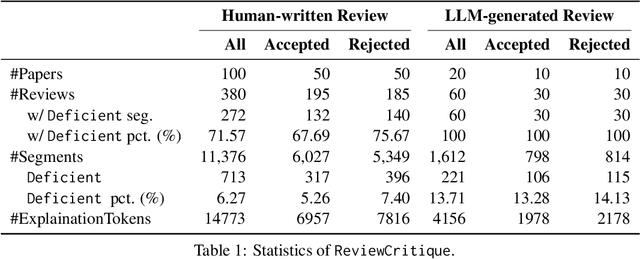
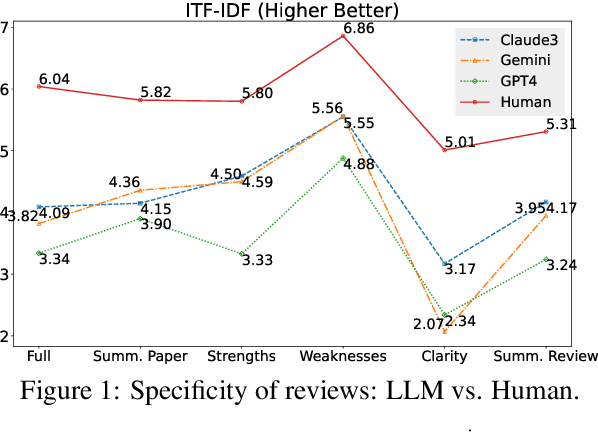
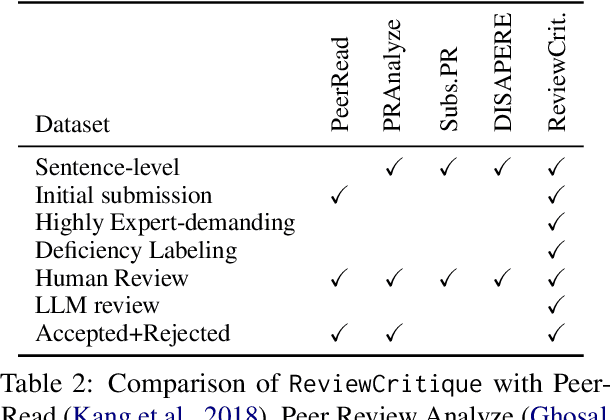
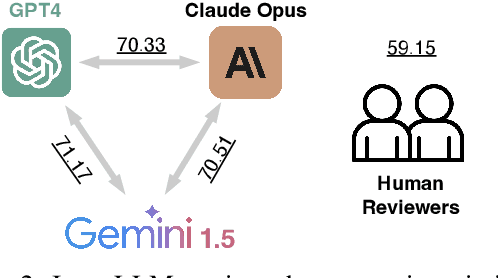
Abstract:This work is motivated by two key trends. On one hand, large language models (LLMs) have shown remarkable versatility in various generative tasks such as writing, drawing, and question answering, significantly reducing the time required for many routine tasks. On the other hand, researchers, whose work is not only time-consuming but also highly expertise-demanding, face increasing challenges as they have to spend more time reading, writing, and reviewing papers. This raises the question: how can LLMs potentially assist researchers in alleviating their heavy workload? This study focuses on the topic of LLMs assist NLP Researchers, particularly examining the effectiveness of LLM in assisting paper (meta-)reviewing and its recognizability. To address this, we constructed the ReviewCritique dataset, which includes two types of information: (i) NLP papers (initial submissions rather than camera-ready) with both human-written and LLM-generated reviews, and (ii) each review comes with "deficiency" labels and corresponding explanations for individual segments, annotated by experts. Using ReviewCritique, this study explores two threads of research questions: (i) "LLMs as Reviewers", how do reviews generated by LLMs compare with those written by humans in terms of quality and distinguishability? (ii) "LLMs as Metareviewers", how effectively can LLMs identify potential issues, such as Deficient or unprofessional review segments, within individual paper reviews? To our knowledge, this is the first work to provide such a comprehensive analysis.
FOFO: A Benchmark to Evaluate LLMs' Format-Following Capability
Feb 28, 2024Abstract:This paper presents FoFo, a pioneering benchmark for evaluating large language models' (LLMs) ability to follow complex, domain-specific formats, a crucial yet underexamined capability for their application as AI agents. Despite LLMs' advancements, existing benchmarks fail to assess their format-following proficiency adequately. FoFo fills this gap with a diverse range of real-world formats and instructions, developed through an AI-Human collaborative method. Our evaluation across both open-source (e.g., Llama 2, WizardLM) and closed-source (e.g., GPT-4, PALM2, Gemini) LLMs highlights three key findings: open-source models significantly lag behind closed-source ones in format adherence; LLMs' format-following performance is independent of their content generation quality; and LLMs' format proficiency varies across different domains. These insights suggest the need for specialized tuning for format-following skills and highlight FoFo's role in guiding the selection of domain-specific AI agents. FoFo is released here at https://github.com/SalesforceAIResearch/FoFo.
Lemur: Harmonizing Natural Language and Code for Language Agents
Oct 10, 2023Abstract:We introduce Lemur and Lemur-Chat, openly accessible language models optimized for both natural language and coding capabilities to serve as the backbone of versatile language agents. The evolution from language chat models to functional language agents demands that models not only master human interaction, reasoning, and planning but also ensure grounding in the relevant environments. This calls for a harmonious blend of language and coding capabilities in the models. Lemur and Lemur-Chat are proposed to address this necessity, demonstrating balanced proficiencies in both domains, unlike existing open-source models that tend to specialize in either. Through meticulous pre-training using a code-intensive corpus and instruction fine-tuning on text and code data, our models achieve state-of-the-art averaged performance across diverse text and coding benchmarks among open-source models. Comprehensive experiments demonstrate Lemur's superiority over existing open-source models and its proficiency across various agent tasks involving human communication, tool usage, and interaction under fully- and partially- observable environments. The harmonization between natural and programming languages enables Lemur-Chat to significantly narrow the gap with proprietary models on agent abilities, providing key insights into developing advanced open-source agents adept at reasoning, planning, and operating seamlessly across environments. https://github.com/OpenLemur/Lemur
XGen-7B Technical Report
Sep 07, 2023Abstract:Large Language Models (LLMs) have become ubiquitous across various domains, transforming the way we interact with information and conduct research. However, most high-performing LLMs remain confined behind proprietary walls, hindering scientific progress. Most open-source LLMs, on the other hand, are limited in their ability to support longer sequence lengths, which is a key requirement for many tasks that require inference over an input context. To address this, we have trained XGen, a series of 7B parameter models on up to 8K sequence length for up to 1.5T tokens. We have also finetuned the XGen models on public-domain instructional data, creating their instruction-tuned counterparts (XGen-Inst). We open-source our models for both research advancements and commercial applications. Our evaluation on standard benchmarks shows that XGen models achieve comparable or better results when compared with state-of-the-art open-source LLMs. Our targeted evaluation on long sequence modeling tasks shows the benefits of our 8K-sequence models over 2K-sequence open-source LLMs.
Mask-free OVIS: Open-Vocabulary Instance Segmentation without Manual Mask Annotations
Mar 29, 2023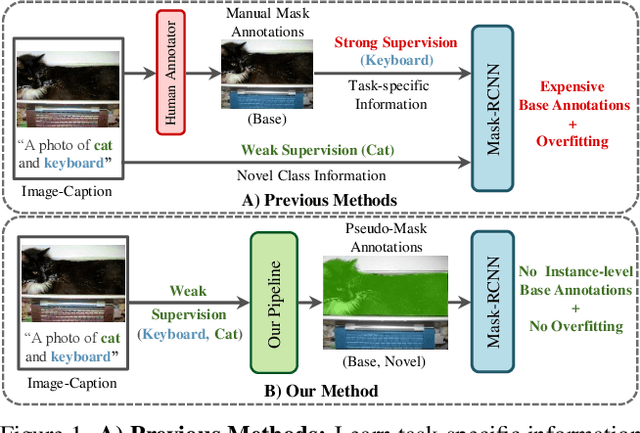
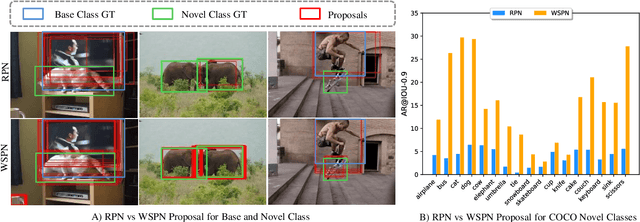
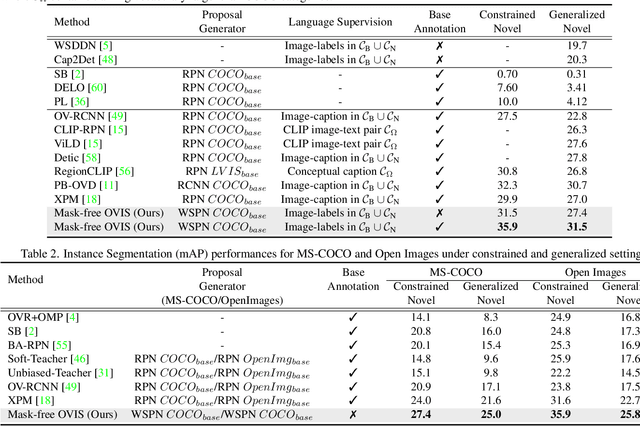
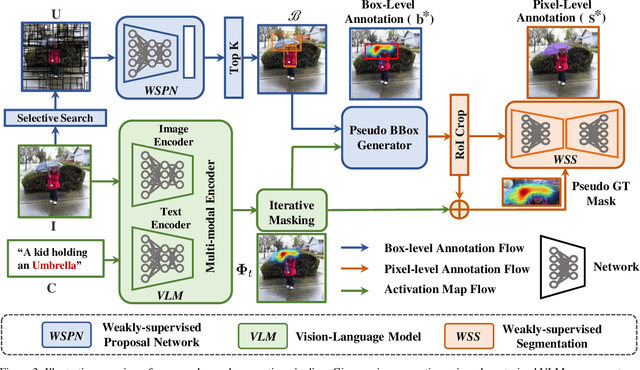
Abstract:Existing instance segmentation models learn task-specific information using manual mask annotations from base (training) categories. These mask annotations require tremendous human effort, limiting the scalability to annotate novel (new) categories. To alleviate this problem, Open-Vocabulary (OV) methods leverage large-scale image-caption pairs and vision-language models to learn novel categories. In summary, an OV method learns task-specific information using strong supervision from base annotations and novel category information using weak supervision from image-captions pairs. This difference between strong and weak supervision leads to overfitting on base categories, resulting in poor generalization towards novel categories. In this work, we overcome this issue by learning both base and novel categories from pseudo-mask annotations generated by the vision-language model in a weakly supervised manner using our proposed Mask-free OVIS pipeline. Our method automatically generates pseudo-mask annotations by leveraging the localization ability of a pre-trained vision-language model for objects present in image-caption pairs. The generated pseudo-mask annotations are then used to supervise an instance segmentation model, freeing the entire pipeline from any labour-expensive instance-level annotations and overfitting. Our extensive experiments show that our method trained with just pseudo-masks significantly improves the mAP scores on the MS-COCO dataset and OpenImages dataset compared to the recent state-of-the-art methods trained with manual masks. Codes and models are provided in https://vibashan.github.io/ovis-web/.
 Add to Chrome
Add to Chrome Add to Firefox
Add to Firefox Add to Edge
Add to Edge